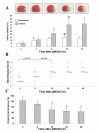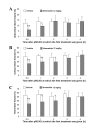Effects of the cyclooxygenase-2 inhibitor nimesulide on cerebral infarction and neurological deficits induced by permanent middle cerebral artery occlusion in the rat
- PMID: 15656909
- PMCID: PMC546225
- DOI: 10.1186/1742-2094-2-3
Effects of the cyclooxygenase-2 inhibitor nimesulide on cerebral infarction and neurological deficits induced by permanent middle cerebral artery occlusion in the rat
Abstract
BACKGROUND: Previous studies suggest that the cyclooxygenase-2 (COX-2) inhibitor nimesulide has a remarkable protective effect against different types of brain injury including ischemia. Since there are no reports on the effects of nimesulide on permanent ischemic stroke and because most cases of human stroke are caused by permanent occlusion of cerebral arteries, the present study was conducted to assess the neuroprotective efficacy of nimesulide on the cerebral infarction and neurological deficits induced by permanent middle cerebral artery occlusion (pMCAO) in the rat. METHODS: Ischemia was induced by permanent occlusion of the middle cerebral artery in rats, via surgical insertion of a nylon filament into the internal carotid artery. Infarct volumes (cortical, subcortical and total) and functional recovery, assessed by neurological score evaluation and rotarod performance test, were performed 24 h after pMCAO. In initial experiments, different doses of nimesulide (3, 6 and 12 mg/kg; i.p) or vehicle were administered 30 min before pMCAO and again at 6, 12 and 18 h after stroke. In later experiments we investigated the therapeutic time window of protection of nimesulide by delaying its first administration 0.5-4 h after the ischemic insult. RESULTS: Repeated treatments with nimesulide dose-dependently reduced cortical, subcortical and total infarct volumes as well as the neurological deficits and motor impairment resulting from permanent ischemic stroke, but only the administration of the highest dose (12 mg/kg) was able to significantly (P < 0.01) diminish infarct volume. The lower doses failed to significantly reduce infarction but showed a beneficial effect on neurological function. Nimesulide (12 mg/kg) not only reduced infarct volume but also enhanced functional recovery when the first treatment was given up to 2 h after stroke. CONCLUSIONS: These data show that nimesulide protects against permanent focal cerebral ischemia, even with a 2 h post-treatment delay. These findings have important implications for the therapeutic potential of using COX-2 inhibitors in the treatment of stroke.
Figures


References
-
- Dugan LL, Choi DW. Hypoxic-ischemic brain injury and oxidative stress. In: Siegel GJ, Agranoff BW, Albers RW, Fisher SK, Uhler MD, editor. Basic Neurochemistry: Molecular, Cellular and Medical Aspects. Sixth. Philadelphia: Lippincott-Raven Publishers; 1999. pp. 711–729.
-
- Nagayama M, Niwa K, Nagayama T, Ross ME, Iadecola C. The cyclooxygenase-2 inhibitor NS-398 ameliorates ischemic brain injury in wild-type mice but not in mice with deletion of the inducible nitric oxide synthase gene. J Cereb Blood Flow Metab. 1999;19:1213–1219. doi: 10.1097/00004647-199911000-00005. - DOI - PubMed
LinkOut - more resources
Full Text Sources
Other Literature Sources
Research Materials

